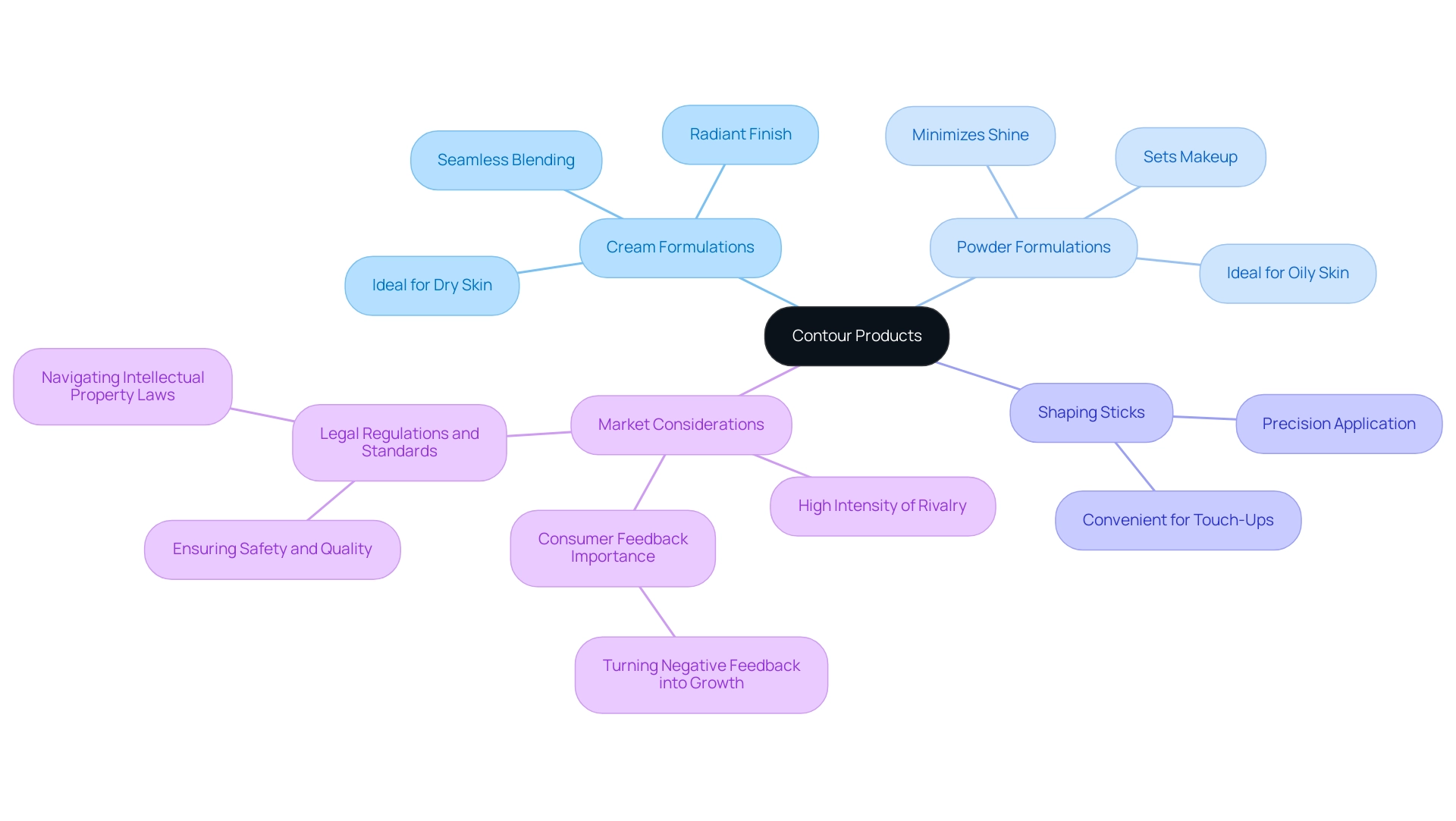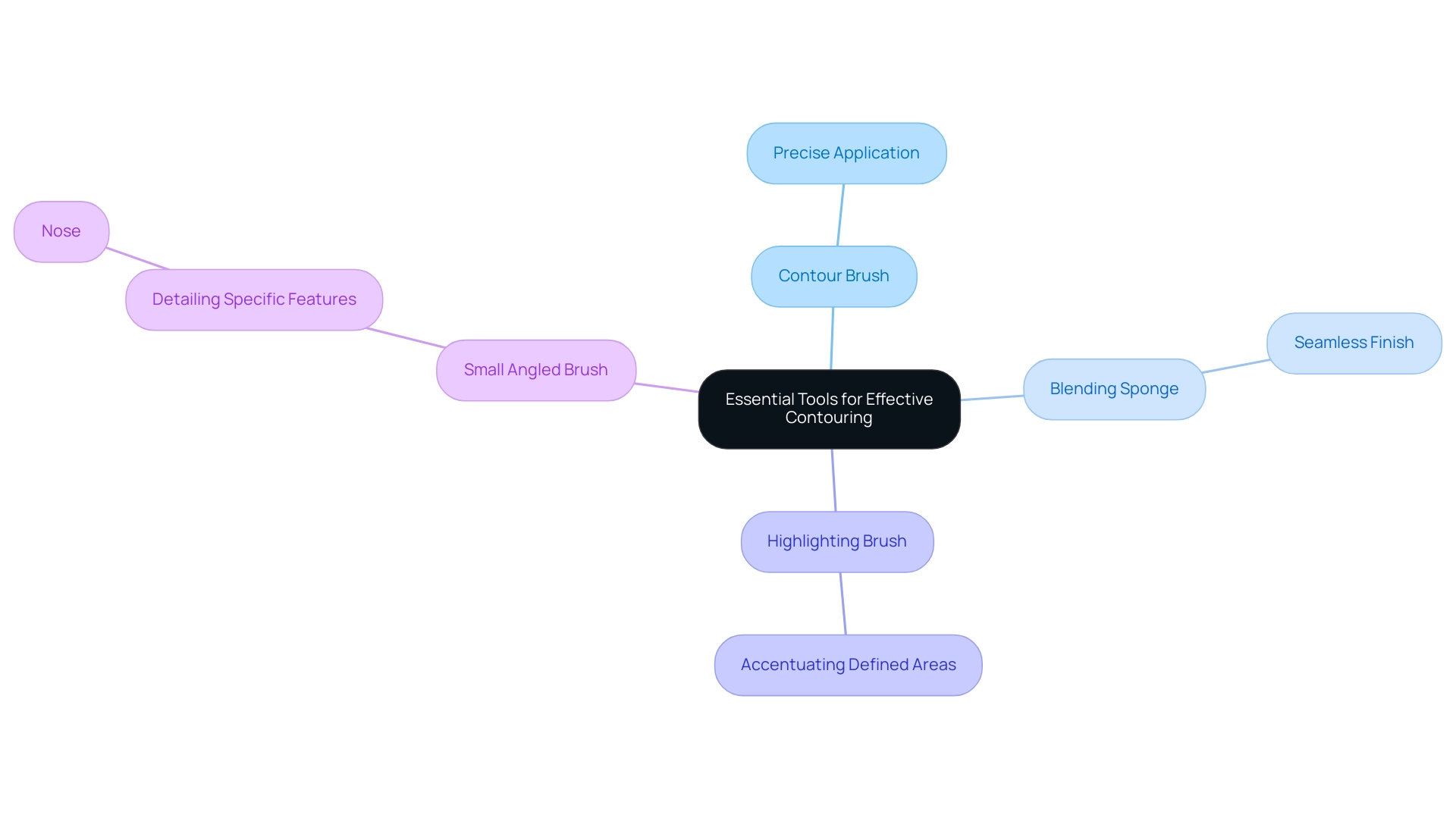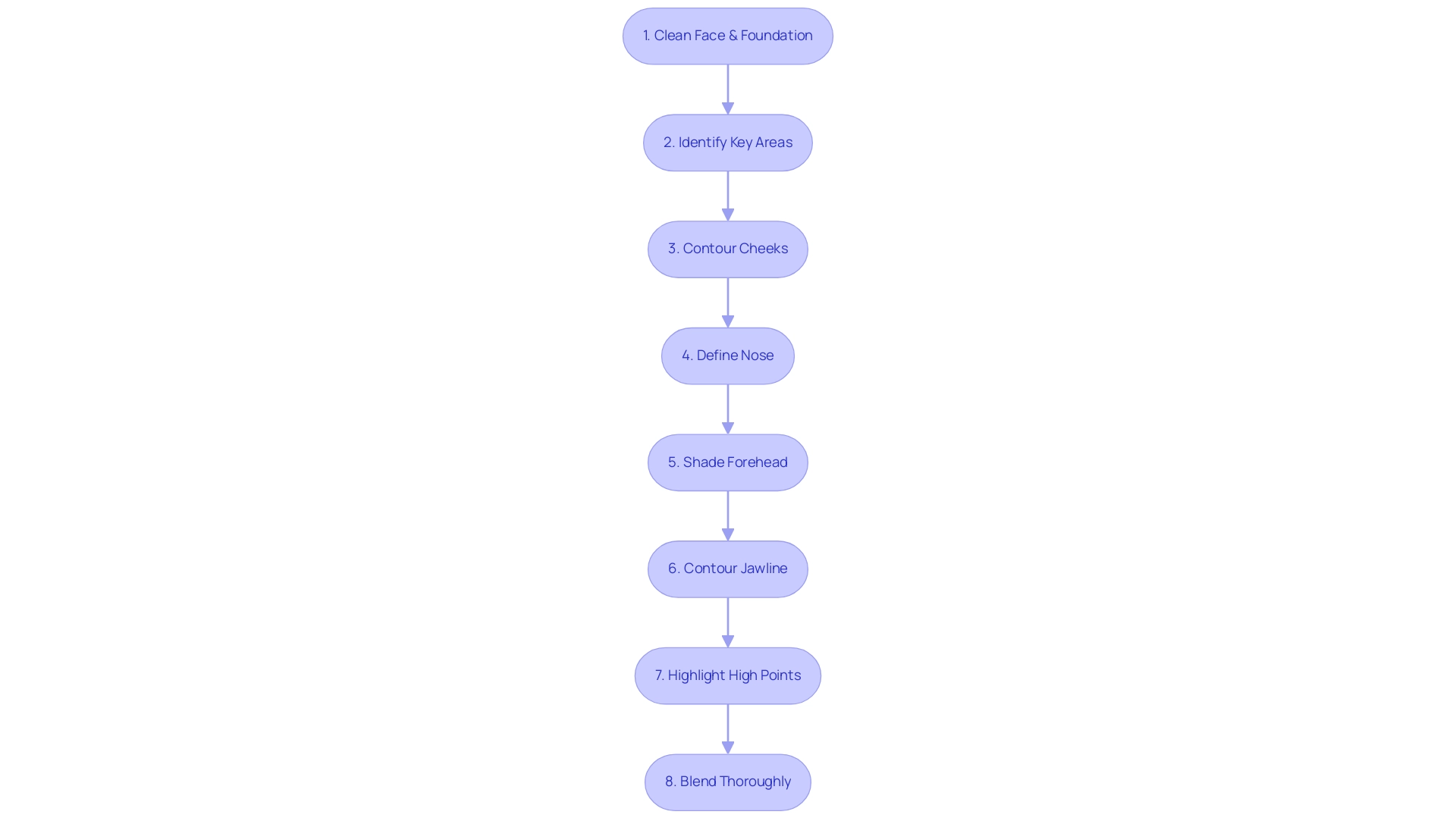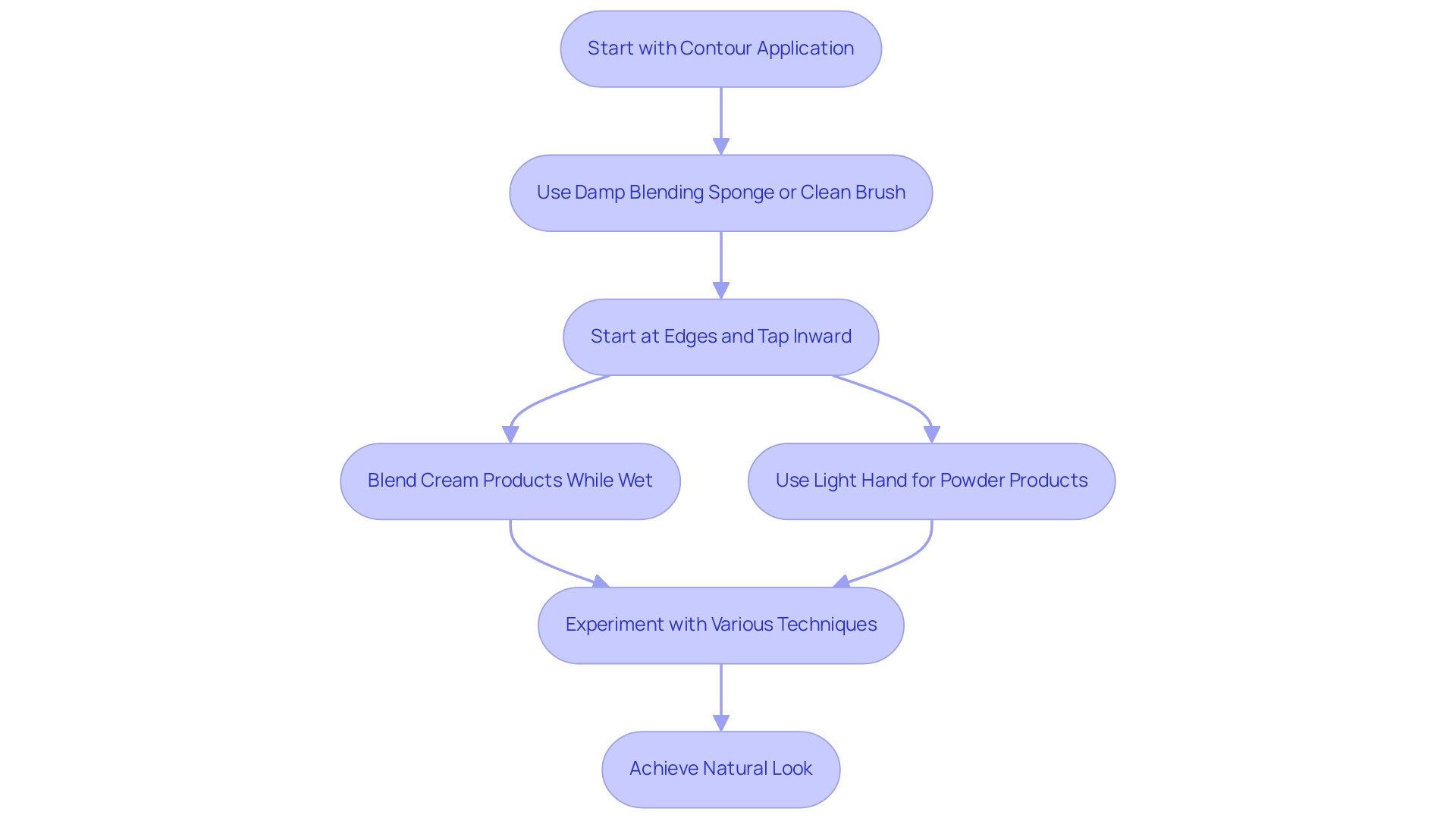Overview
The article provides a comprehensive step-by-step guide for beginners on how to effectively use contour products to enhance facial features. It emphasizes the importance of understanding skin types, choosing the right shades, and mastering blending techniques to achieve a natural look, supported by practical tips and common mistakes to avoid in the contouring process.
Introduction
In the world of beauty, contouring has emerged as a powerful technique that can transform one's appearance and enhance natural features. This artful application of shadows and highlights allows individuals to sculpt their faces, creating defined cheekbones, slimmer noses, and an overall polished look. As social media continues to play a pivotal role in shaping beauty trends, the demand for contouring products is on the rise, with the market projected to grow significantly in the coming years.
However, mastering the art of contouring goes beyond merely applying makeup; it involves understanding the nuances of different products, the importance of blending, and the need for personalized solutions that cater to diverse skin tones. This article delves into the essentials of contouring, providing insights into techniques, tools, and common pitfalls to avoid, ensuring that anyone can achieve a radiant and balanced complexion.
Understanding Contouring: The Basics of Makeup Enhancement
Contouring is a transformative makeup technique designed to enhance the natural structure of the face through strategic application of shadows and highlights. By skillfully using contour products, individuals can define their cheekbones, slim their noses, and add dimension to their foreheads and jawlines. The essence of effective contouring lies in understanding which areas to accentuate and mastering the application for a harmonious finish.
As Noreen Galaria notes, there is an increasing awareness of beauty techniques driven by social media education, particularly regarding the importance of sun protection. This increasing awareness corresponds with the key point that improved sunscreen application is becoming a priority among consumers, highlighting the necessity for items that not only enhance beauty but also safeguard the skin. In 2024, the shaping cosmetic kit market is anticipated to expand at a CAGR of 6.28%, indicating the increasing demand for products that accommodate distinct skin tones and facial characteristics.
This shift highlights the significance of shaping not just as a beauty trend, but as a means to embrace and enhance individual beauty. OSM's brand philosophy—'Take It Slow'—resonates with this consumer mindset, highlighting the need for thoughtful beauty choices in a fast-paced world. Additionally, the increasing demand for personalized beauty solutions illustrates how contour products can capitalize on this trend, providing a variety of shades and textures that meet evolving consumer needs.
When used correctly, sculpting can significantly change one’s appearance, allowing for a polished look that enhances natural beauty rather than obscuring it. As makeup artists often emphasize, the goal is to achieve a balanced and radiant complexion, making contouring an essential skill in contemporary makeup artistry.
Exploring Different Types of Contour Products
A variety of formulations, including creams, powders, and sticks, are available in contour products, each offering distinct benefits tailored to different skin types.
- Cream formulations are particularly advantageous for those with dry skin, as their creamy consistency facilitates seamless blending and delivers a radiant, dewy finish.
- In contrast, powder formulations are well-suited for oily skin, effectively setting makeup and minimizing shine throughout the day.
For added convenience, shaping sticks offer precision application, making them ideal for touch-ups on the go. As the contouring items market experiences high intensity of rivalry, it’s essential to consider consumer reviews and feedback when selecting options. Turning negative social media feedback into growth opportunities is crucial; as one expert noted, 'Dealing with negative feedback on social media is tough.
How do you turn criticism into opportunity?'
When choosing contour products, it’s essential to consider your unique skin type and the finish you wish to achieve. Conducting trials with different contour products can help you discover which items best suit your needs.
Additionally, adherence to legal regulations and industry standards is critical for ensuring safety and quality, which in turn maintains consumer trust. Significantly, as the shaping market keeps advancing, new items introduced in 2024 are offering creative solutions to improve your cosmetic routine. Stay informed about these developments to make the most out of your shaping experience.

Essential Tools for Effective Contouring
Attaining perfect shaping starts with choosing the appropriate instruments, which are crucial for enhancing your cosmetic application to professional levels in a flourishing skincare sector worth $180.3 billion. Key items include contour products such as:
- A contour brush designed for precise application
- A blending sponge for achieving a seamless finish
- A highlighting brush for accentuating defined areas on your face
- A small angled brush for detailing specific features, such as the nose
Investing in high-quality brushes and sponges is crucial, as they can significantly enhance your contour products and reflect the professional standards upheld by beauty artists, who earn a median wage of $22.79 hourly. According to industry insights, consumers typically spend an average of $185 annually on cosmetic tools, underscoring the importance of choosing quality over quantity. As HR Management advises, "Protect your brand image when personal values and client expectations conflict."
This highlights the necessity of maintaining quality and integrity in makeup application. Regularly cleaning your tools is also vital to maintain hygiene and ensure a smooth application, which ultimately contributes to the overall effectiveness of your contour products technique.

Step-by-Step Application: How to Contour Like a Pro
- Begin with a clean, moisturized face, applying foundation to create an even base.
- Identify the key areas to shape using contour products: the hollows of your cheeks, sides of your nose, forehead, and jawline.
- With your selected contour products, draw a line in the hollows of your cheeks, blending upwards towards your temples for a natural look.
- For the nose, apply definition along the sides and blend carefully to achieve a slimmer appearance.
- On your forehead, apply shading along the hairline, blending downwards to create dimension.
- For the jawline, apply contour products along the jaw and blend downwards for definition.
- Highlight the high points of your face—such as the tops of your cheekbones, brow bones, and the bridge of your nose—with a highlighter for a radiant finish.
- Finally, blend all areas thoroughly to achieve a seamless and polished look.
Makeup artists recommend starting with smaller sections and using a steady hand for the best results. This technique not only enhances your features but also allows for a customizable approach based on individual preferences. As noted by Reviewer #1, cosmetics can be a strategy to enhance social status, highlighting its psychological implications. Furthermore, studies show that participants took an average of 30 minutes to complete makeup application surveys, emphasizing the time investment in achieving a flawless look. Comprehending the impact of media and social networks on body image also situates the significance of mastering shaping techniques, as these factors greatly influence societal views of beauty.

Common Contouring Mistakes and How to Avoid Them
- Overusing material: A frequent mistake in shaping is the inclination to apply excessive substance at once. Start with a small amount of contour products and gradually build up to your desired intensity. This approach allows for easier adjustments, making it simpler to add more rather than trying to remove excess product.
- Not blending enough: The key to achieving a seamless, natural look lies in effective blending. Take the time to blend out any harsh lines; this will ensure that your shading appears soft and integrated into your overall makeup. Expert advice emphasizes that using well-blended contour products is crucial for a polished finish.
- Using the wrong shade: Selecting the appropriate sculpting shade is vital. Aim for a shade that is 1-2 tones darker than your natural skin tone, steering clear of overly warm hues that can seem unnatural. Choosing the right shade of contour products helps to create shadow and definition without looking artificial.
- Forgetting to highlight: Balancing your shading with highlighting is essential for adding dimension to your face. Skipping the highlight step can lead to a flat appearance. Highlights attract focus to your finest attributes and improve the overall impact of your shading.
- Applying contour products in the wrong areas: Understanding your unique face shape is crucial for effective sculpting. Apply the shading in areas that enhance your features for the most flattering results. Misplacing contour can lead to an unbalanced look, which is a common error that can be easily avoided with a little knowledge and practice.
In the realm of cosmetics, many individuals, including those like Susan, have discovered that using products like Boomstick Color not only simplifies their application process but also enhances their natural beauty. As Cindy Joseph, founder of Boomstick, states, "And we are not the only ones who think age is beautiful." Additionally, remember to use a good quality eye cream prior to applying cosmetics to ensure a smooth base.
Also, applying cosmetics in natural lighting or with soft white bulbs can significantly improve the outcome, avoiding the pitfalls of poor lighting. By avoiding these common shaping mistakes and implementing effective techniques, you can achieve a radiant look that celebrates your unique features.
The Art of Blending: Key to Natural-Looking Contour
Blending stands out as the most essential step in using contour products, transforming your makeup from stark lines to a seamless, natural finish. According to consumer preferences, a significant percentage of individuals prioritize blending techniques to achieve a polished look. To achieve this, utilize a damp blending sponge or a clean brush to soften any harsh lines left from your application.
Begin at the edges of the contour and work your way inward toward the center of your face using gentle tapping motions. When working with cream items, blending while the substance is still wet yields the best results, allowing for a smoother application. In contrast, with powder products, exercise a light hand to prevent disrupting the foundation underneath.
Artists often emphasize that mastering the art of blending can elevate your cosmetic skills significantly, affirming its importance in achieving a polished appearance. It's also noteworthy that the type of eyeshadow formula used affects the blending technique; for instance, powder eyeshadows require brushes, while cream or liquid shadows can be blended with fingers. This practical insight highlights the versatility required in blending techniques.
Furthermore, the global cosmetics industry, led by nations like France and China, underscores the significance of quality blending techniques as part of the overall makeup experience. Experiment with various techniques to discover what suits you best, and remember: this step is not one to rush. The right blending technique can truly make or break your use of contour products, culminating in a beautiful, natural appearance.

Choosing the Right Contour Shade for Your Skin Tone
Choosing the right shading begins with a deep understanding of your skin tone and undertone. As Rihanna noted, she was the first to address this market in its entirety, emphasizing the importance of inclusivity in beauty. For individuals with fair skin, it’s advisable to choose a shading product that is both cool-toned and light, which creates subtle definition without overwhelming the complexion.
Those with medium skin tones may find success with neutral or slightly warm shades, striking a balance that enhances their natural beauty. For deeper skin tones, rich, warm tones are ideal, as they can create the desired depth and shadow without appearing muddy. This approach aligns with Fenty Beauty's modern visual identity, which showcases diverse models and highlights the significance of catering to various skin tones.
It is crucial to test the contour products on your jawline, as this area helps to gauge how well they blend with your foundation. Whenever possible, swatch products in natural light to ensure that the chosen shade harmonizes seamlessly with your skin tone. Keep in mind that the primary objective of contour products is to create shadows rather than infuse color; therefore, steer clear of shades that are excessively dark or exhibit an orange undertone.
Additionally, understanding the emotional elements that drive social media engagement can inform your choices, as they often reflect consumer preferences for authenticity and representation. By following these guidelines, you can achieve a sculpted appearance that enhances your features beautifully while embracing the diversity within the beauty community.
Further Resources: Expanding Your Contouring Knowledge
To enhance your shaping skills, a variety of resources are at your disposal:
- Online Tutorials and Makeup Courses: Platforms such as Skillshare, Udemy, and MasterClass offer a wealth of knowledge with courses tailored to both beginners and advanced learners. Skillshare focuses on community engagement, Udemy provides a vast library for various skill levels, and MasterClass is known for high-quality production with celebrity instructors. These resources not only teach techniques but also foster a community of beauty enthusiasts, contributing to the overall growth and diversity of online beauty education.
- Specialized Makeup Books: Books dedicated to contour products and highlighting provide essential visual aids and step-by-step guidance, making complex techniques more accessible. Titles that focus on these areas are invaluable for mastering the art of makeup.
- Social Media Platforms: With the skincare industry booming at an estimated $180.3 billion globally, social media plays a crucial role in makeup education. Influencers on Instagram and YouTube frequently share innovative techniques and tips, making these platforms essential for staying updated with the latest trends. According to recent insights, personalized recommendations increase the likelihood of purchase by 75%, underscoring the influence of these platforms on learning. Significantly, hair coloring items alone represent 1/5th of the global haircare market, highlighting the scale of the beauty industry.
- Hands-On Practice: Experimenting with various products and techniques allows you to find what complements your unique features best. Engaging with various styles will not only enhance your skills but also assist you in developing a personalized shaping method. With dedication and practice, you’ll refine your techniques and create a unique contouring style using contour products.
Conclusion
Mastering the art of contouring is more than just a makeup trend; it is a transformative technique that enhances individual beauty and fosters confidence. By understanding the basics of contouring, including the selection of appropriate products, tools, and techniques, anyone can achieve a sculpted and polished look that emphasizes their natural features.
Key aspects such as:
- Choosing the right contour shade for your skin tone
- The importance of blending
- Avoiding common pitfalls
are crucial for success. The variety of contour products available caters to different skin types and preferences, allowing for personalized beauty solutions. Moreover, the emergence of online resources and social media has made it easier than ever to learn and refine contouring skills, encouraging a community of beauty enthusiasts to share knowledge and techniques.
Ultimately, contouring is about celebrating individuality and enhancing one's unique features. With the right approach and practice, anyone can master this skill, leading to a radiant and balanced complexion that reflects their inner beauty. Embracing contouring as part of a thoughtful beauty routine not only showcases personal style but also empowers individuals to feel their best every day.
Frequently Asked Questions
What is contouring in makeup?
Contouring is a transformative makeup technique that enhances the natural structure of the face by strategically applying shadows and highlights to define features like cheekbones, noses, foreheads, and jawlines.
Why is contouring becoming more popular?
The popularity of contouring is increasing due to heightened awareness of beauty techniques driven by social media education, which emphasizes the importance of sun protection and the demand for products that enhance beauty while safeguarding the skin.
What is the forecast for the shaping cosmetic kit market?
The shaping cosmetic kit market is anticipated to expand at a compound annual growth rate (CAGR) of 6.28% in 2024, indicating growing demand for products that cater to distinct skin tones and facial characteristics.
What is OSM's brand philosophy regarding beauty?
OSM's brand philosophy, 'Take It Slow,' reflects a consumer mindset that values thoughtful beauty choices in a fast-paced world, emphasizing the importance of personalized beauty solutions.
What types of formulations are available for contour products?
Contour products are available in various formulations, including creams, powders, and sticks, each offering distinct benefits tailored to different skin types.
Which contour formulation is best for dry skin?
Cream formulations are particularly advantageous for dry skin as they provide seamless blending and a radiant, dewy finish.
Which contour formulation is suitable for oily skin?
Powder formulations are well-suited for oily skin, as they effectively set makeup and minimize shine throughout the day.
What advantages do shaping sticks offer?
Shaping sticks provide precision application, making them ideal for touch-ups on the go.
How should consumers approach selecting contour products?
Consumers should consider their unique skin type and desired finish when selecting contour products and conduct trials with different items to find the best fit for their needs.
Why is it important to adhere to legal regulations in the shaping market?
Adhering to legal regulations and industry standards is critical for ensuring safety and quality, which helps maintain consumer trust in contour products.
What should consumers stay informed about regarding contour products?
Consumers should stay informed about new product developments in the shaping market to make the most out of their contouring experience.



